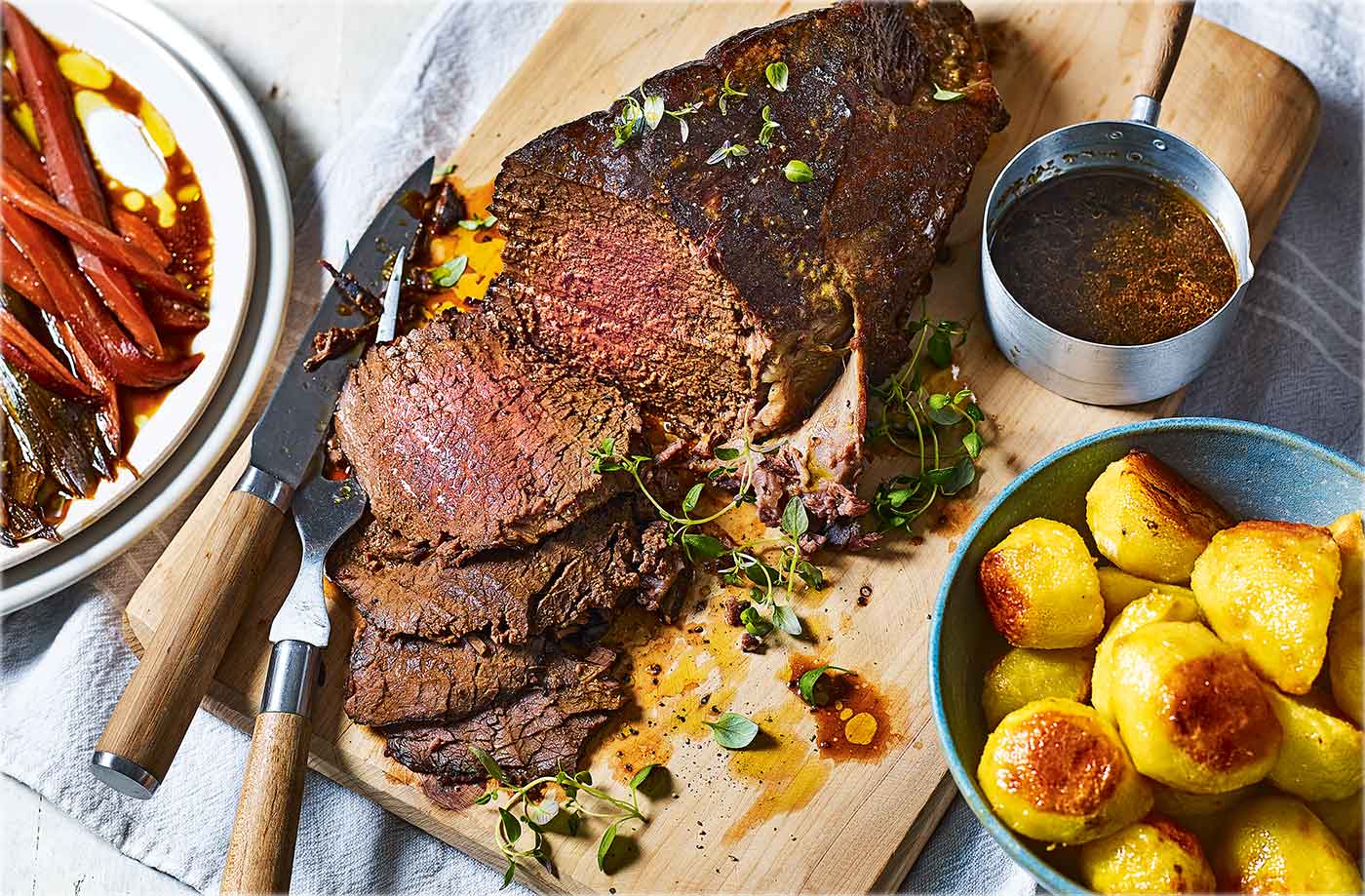How to cook roast meat?
Roasting is a cooking method that uses dry heat where hot air envelops the food, cooking it evenly on all sides with temperatures of at least 150 °C (300 °F) from an open flame, oven, or another heat source. Roasting can enhance flavor through caramelization and Maillard browning on the surface of the food. Roasting uses indirect, diffused heat (as in an oven), and is suitable for slower cooking of meat in a larger, whole piece. Meats and most root and bulb vegetables can be roasted. Any piece of meat, especially red meat, that has been cooked in this fashion is called a roast. Meats and vegetables prepared in this way are described as "roasted", e.g., roasted chicken or roasted squash.
Roasting is one of the easiest ways there is to cook a large cut of meat, whether it's beef, pork or lamb.
Roasting at low temperatures (between 275°F and 325°F) provides the most flavorful, juicy and tender results. Lower temperatures also minimize shrinkage and help the meat cook evenly. Generally, the larger the cut of meat, the lower the roasting temperature should be.
The only problem is that these lower temperatures don't produce a brown, flavorful crust on the exterior of the meat. Therefore, we'll typically begin roasting at a high temperature to get the meat nice and brown and then lower the temperature for the duration of cooking.
About Meat
Before the invention and widespread use of stoves, food was primarily cooked over open flames from a hearth. To roast meat, racks with skewers, or, if accessible, complicated gear arrangements, would be utilized to turn the piece(s). In the past, this method was often associated with the upper class and special occasions, rather than customary mealtimes, because it required freshly killed meat and close attention during cooking. It was easy to ruin the meat’s taste with a smoky fire or negligence to rotate it at regular intervals. Thus, elite families, who were able to afford quality meat, appointed this task to servants or invested in technology like automatic turning devices. With further technological advances, cooking came to accommodate new opportunities. By the 1860s, working families were able to afford low-priced stove models that became sufficiently available. However, the key element of observation during roasting became difficult and dangerous to do with the coal oven. Hence, traditional roasting disappeared as kitchens became no longer equipped for this custom and soon thereafter, "baking" came to be called "roasting".
Roasting can be applied to a wide variety of meat. In general, it works best for cooking whole chickens, turkey, and leaner cuts of lamb, pork, and beef. The aim is to highlight the flavor of the meat itself rather than a sauce or stew, as it is done in braising or other moist-heat methods. Many roasts are tied with string prior to roasting, often using the reef knot or the packer's knot. Tying holds them together during roasting, keeping any stuffing inside, and keeps the roast in a round profile, which promotes even cooking.
Red meats such as beef, lamb, and venison, and certain game birds are often roasted to be "pink" or "rare", meaning that the center of the roast is still red. Roasting is a preferred method of cooking for most poultry, and certain cuts of beef, pork, or lamb. Although there is a growing fashion in some restaurants to serve "rose pork", temperature monitoring of the center of the roast is the only sure way to avoid foodborne disease.
In Britain, Ireland, and Australia, a roast of meat may be referred to as a joint, or a leg, if it is a leg.
How to roast?
Season the meat ahead of time (like the night before you plan to roast) so that the flavorings have enough time to penetrate the meat. Seasonings can include Kosher salt and freshly ground black pepper, as well as various spice rubs, fresh or dried herbs, garlic and so forth. Take it out of the fridge about half an hour before you plan to roast it.
Preheat the oven to a high temperature — usually around 450°F, but for my slow roasted pork shoulder, I start at 500°F.
Set the seasoned roast on a rack, fat side up, in a roasting pan. The pan's sides should be relatively low so that the hot air can circulate around the roast. Using a rack (rather than placing the roast directly on the bottom of the pan) also promotes even airflow. Don't cover the pan.
If you are using a meat thermometer (analog or digital), insert the probe into the center of the roast, being careful not to hit bone.
Place the meat in the oven and cook for 20 to 30 minutes at the high temperature. Then lower the temperature to between 275°F and 325°F and roast until done (see doneness guidelines below).
Remove the roast from the oven and let it rest, covered in foil, for 15 to 20 minutes before carving. Resting the meat before slicing it results in a much juicier roast. That's because cooking tends to drive all the meat's natural juices into the center of the roast. Resting it before slicing gives the protein molecules a chance to reabsorb some of that moisture, so those juices don't all spill out onto your cutting board.
While you're waiting for the roast to rest, you can prepare a sauce. Here's a list of sauces for beef and pork. Alternately, you can make a simple velouté sauce by whisking the pan drippings and some additional stock into a butter-flour roux.
Tips
A meat thermometer (the kind you leave in the roast while cooking) is better than an instant-read thermometer when you're roasting a big piece of meat because the instant-read type requires you to poke a new hole every time you measure the roast's temperature. An electronic meat thermometer can be programmed to beep when the meat hits the target temperature.
Beef and lamb are medium rare when the internal temperature of the roast has reached 135°F; medium is 140°-145°F. Pork should be cooked to 145°F. Veal is usually served medium (145°-150°F) or medium-well (155°F).
Remember that the temperature of an average roast can rise another 10 degrees after you take it out of the oven. Therefore, you're going to want to take the roast out of the oven when the thermometer shows a reading about 10 degrees lower than you want it.
Don't baste! Every time you baste, you have to open the oven door, and that lowers the oven temperature. Roasting the meat fat side up allows the fat to drip down over the roast as it melts, thereby keeping the exterior nice and moist.
Although the baked food is delicious, it is not suitable for eating, not only for your good body but also for your health. Be a healthy food lover and enjoy the wonderful taste of food!
Related Articles
Search
Categories
Popular Posts






















Comments: 0
No comments